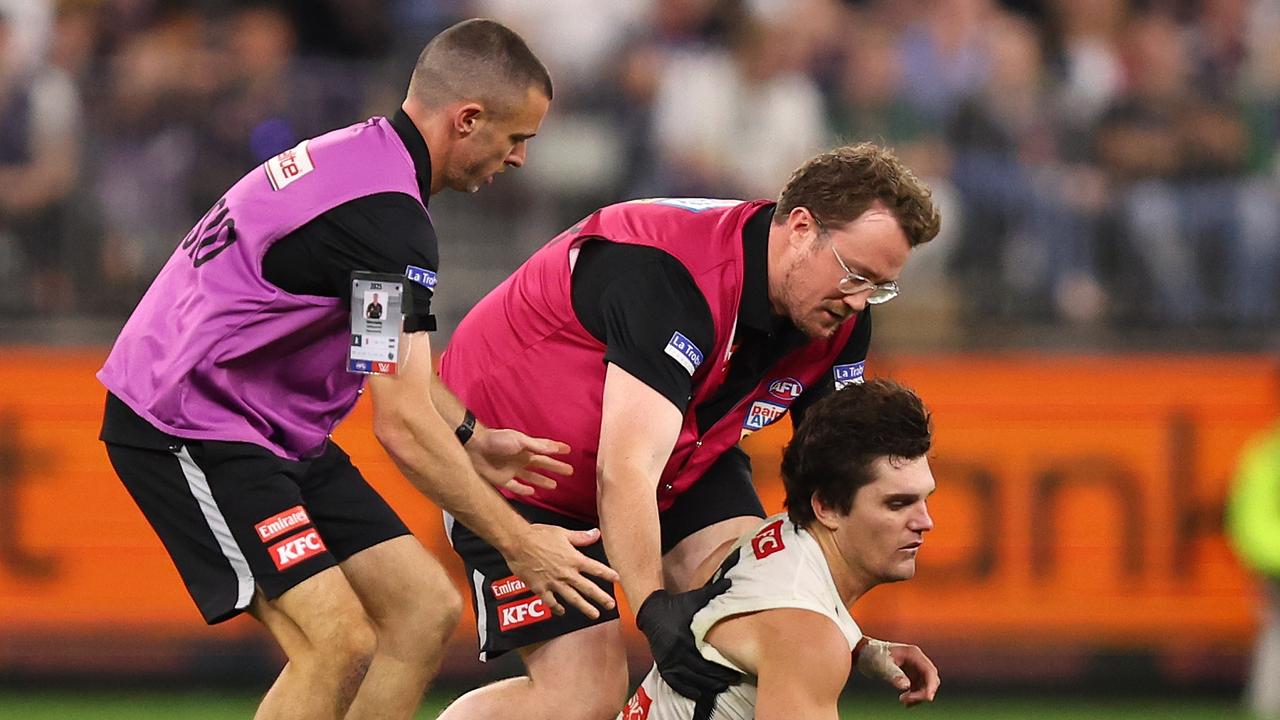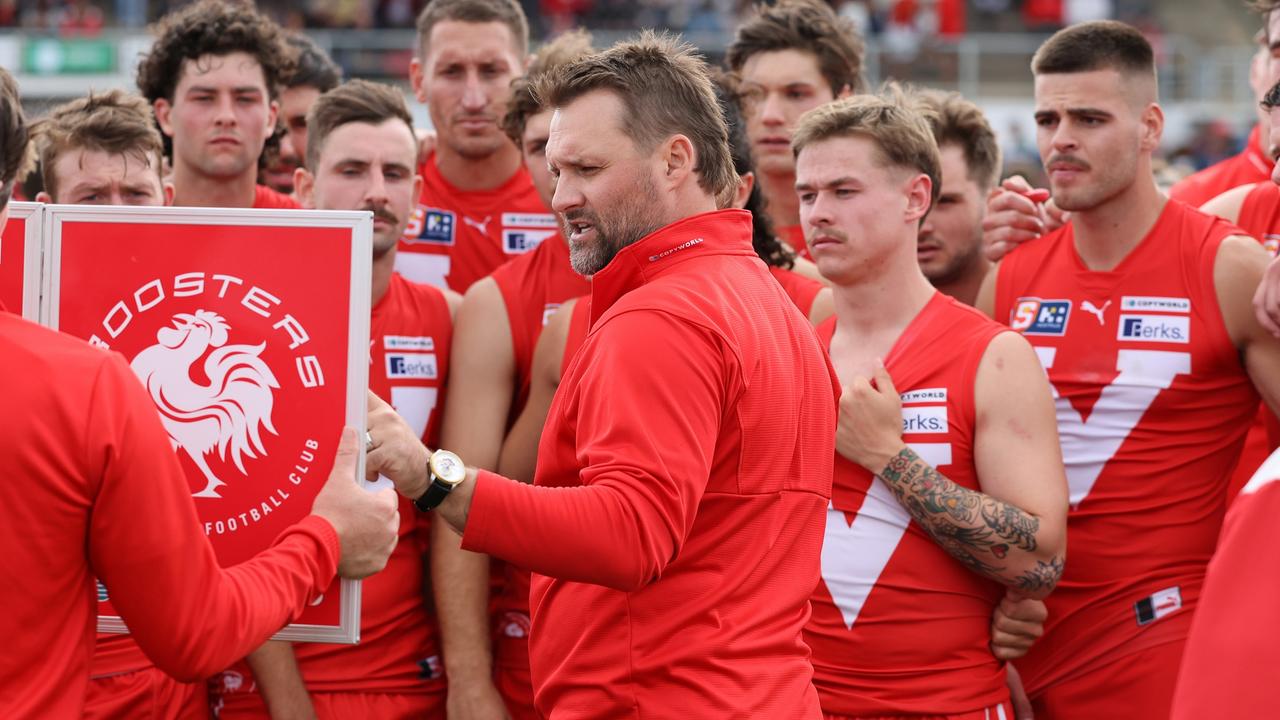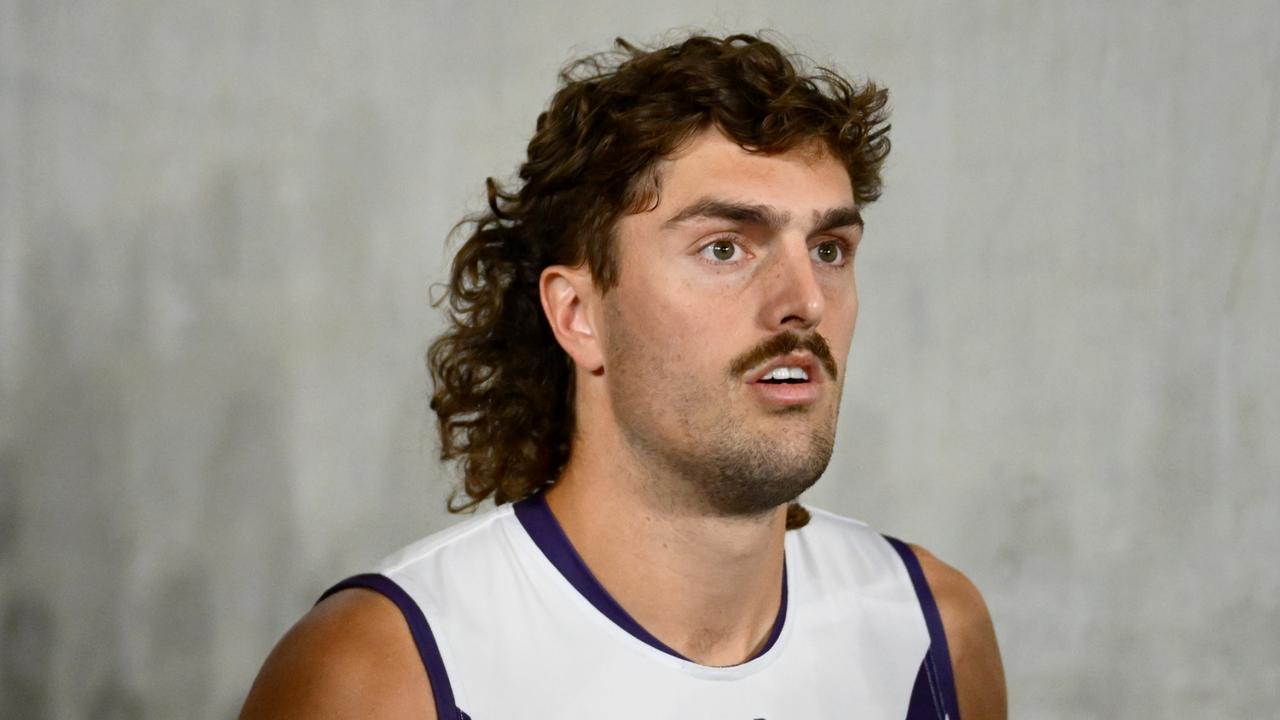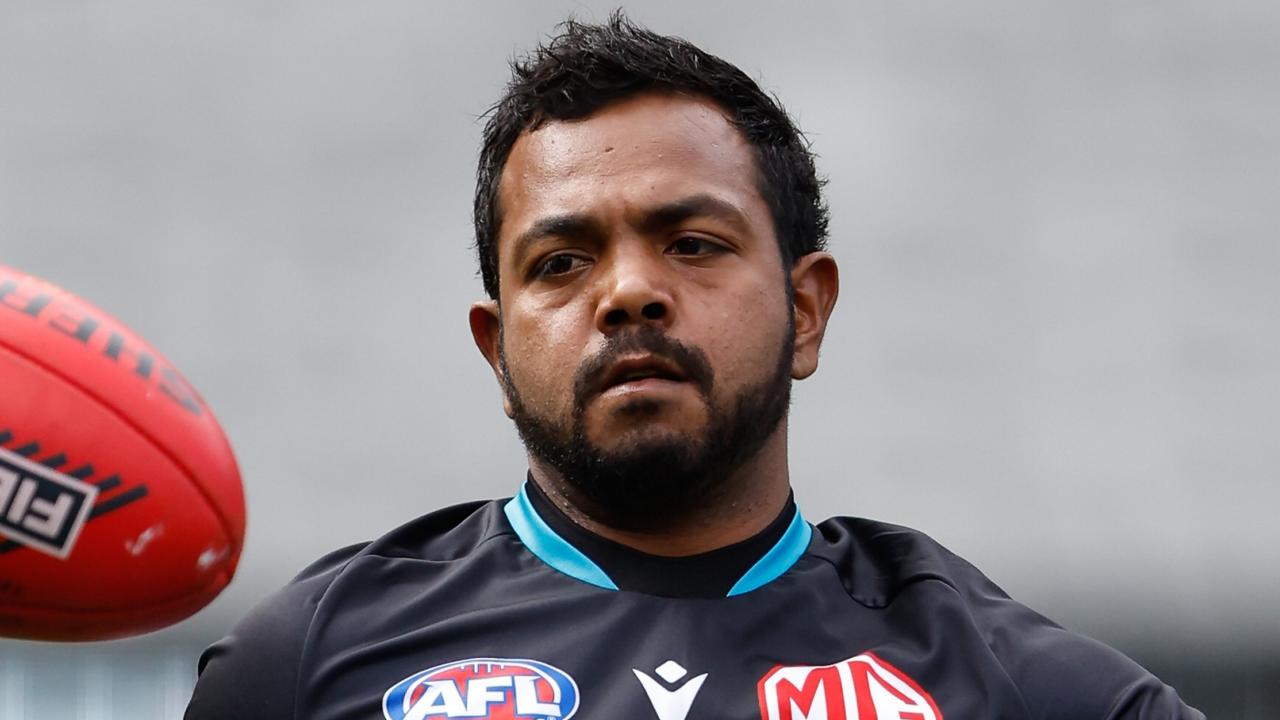Sir Doug Nicholls Round: Every AFL club’s Indigenous round guernsey – and their meaning
Clubs are all-in on Sir Doug Nicholls Round – from embracing their First Nations players to new jumpers. Here’s every clubs Indigenous guernsey – and the story behind it.
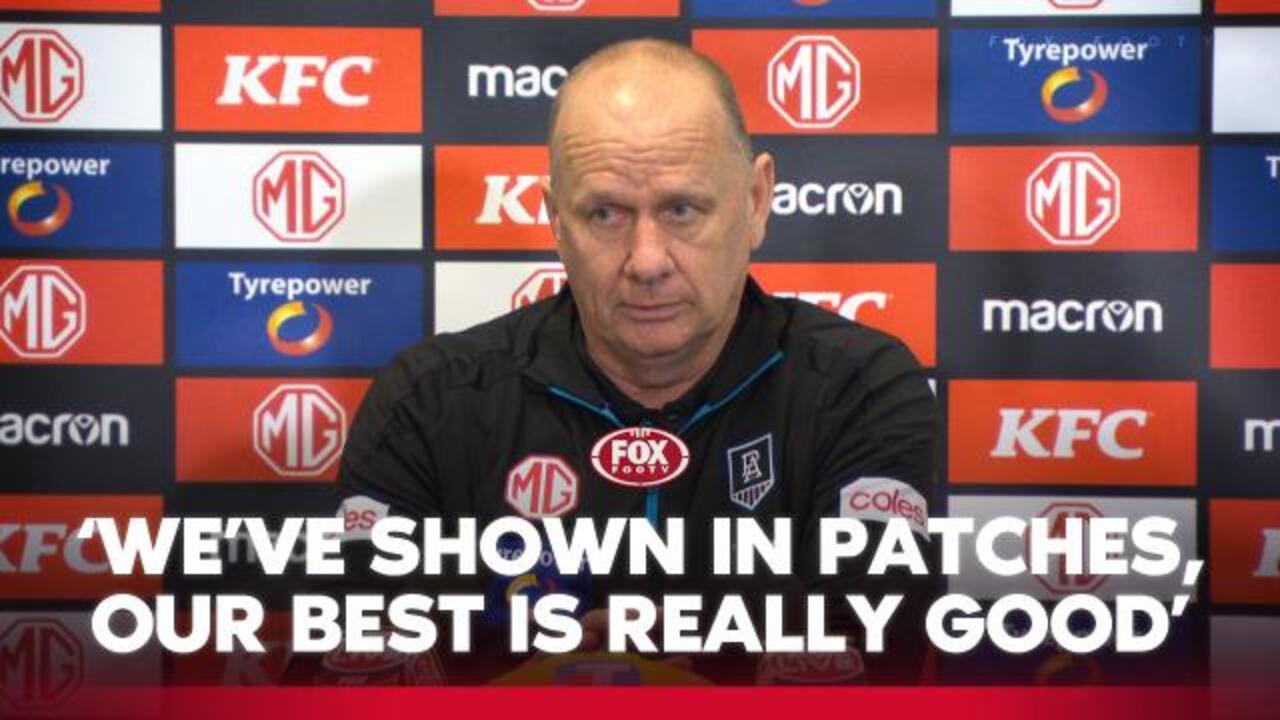
AFL
Don't miss out on the headlines from AFL. Followed categories will be added to My News.
Every club has brought into Sir Doug Nicholls Round by honouring their heritage and their Indigenous players.
We look at the stories behind every club’s jumper.
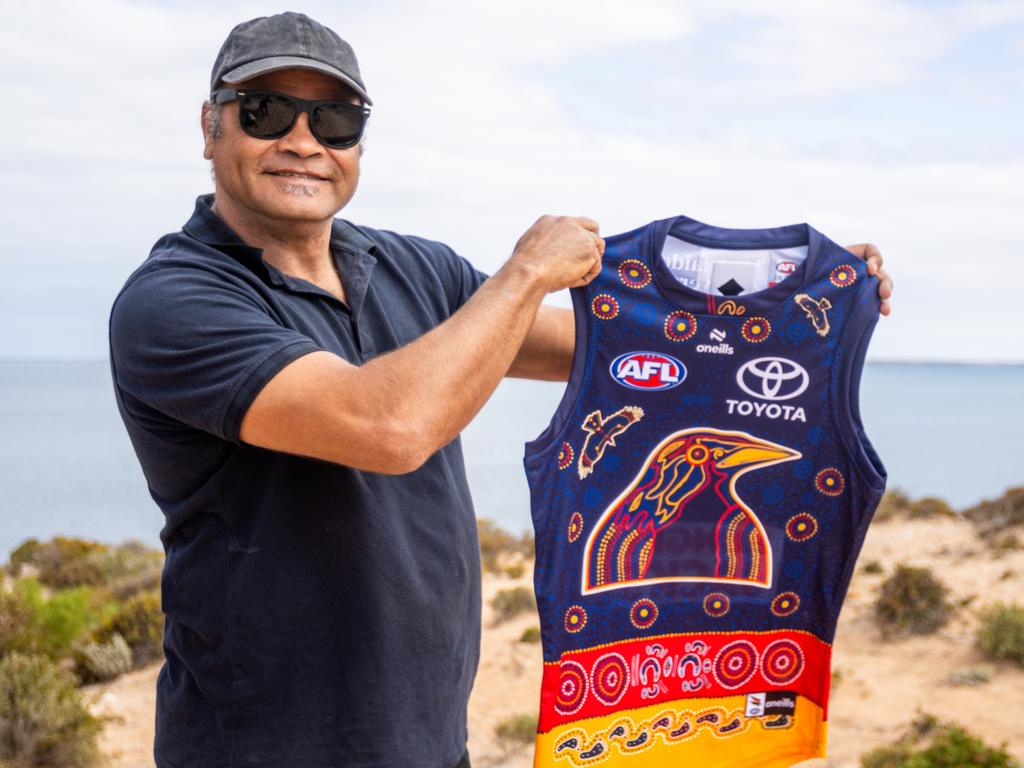
ADELAIDE/KUWARNA
Former player and fan favourite Graham Johncock and Wirangu artist Aunty Christine Tschuna have designed the Crows – who will go by the name Kuwarna – guernsey for Sir Doug Nicholls Round.
Johncock played 227-games from 2002 to 2013 and the design tells of his story growing up on the far west coast of South Australia, to playing juniors at Mallee Park, being drafted by the Crows in 2000 and then returning to Mallee Park after his AFL career finished.
On the jumper there is a large crow, representing his late mother, soaring crows that represent his father and grandmother, circular male and female symbols to represent his family and footprints that show his journey to the club.
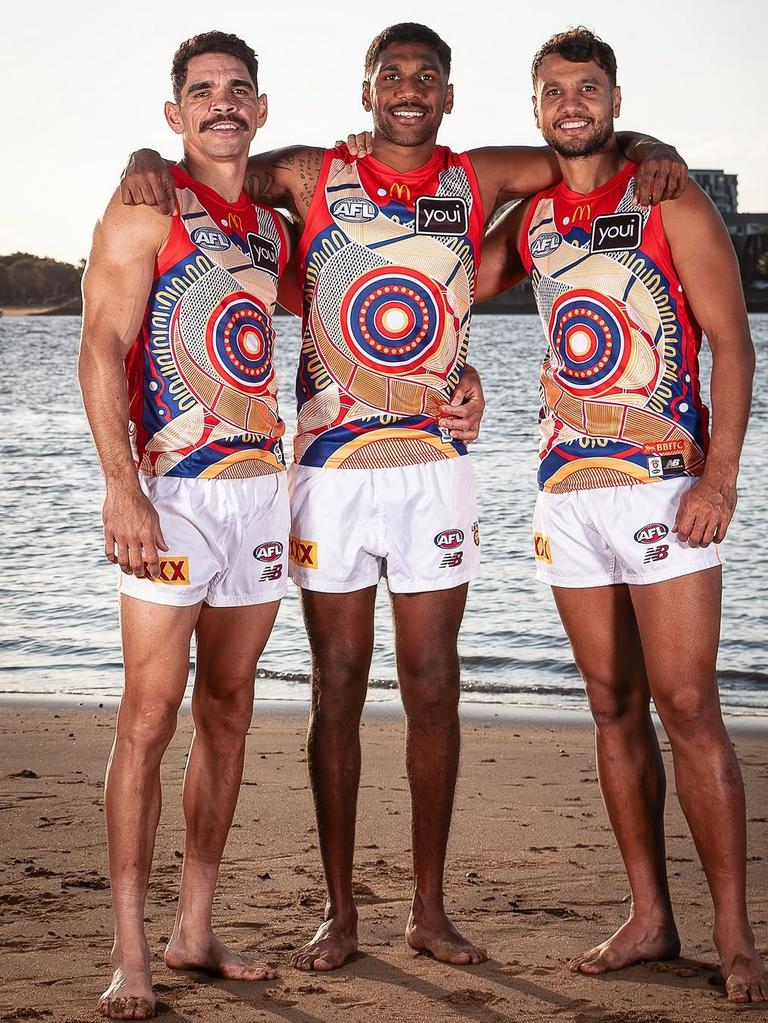
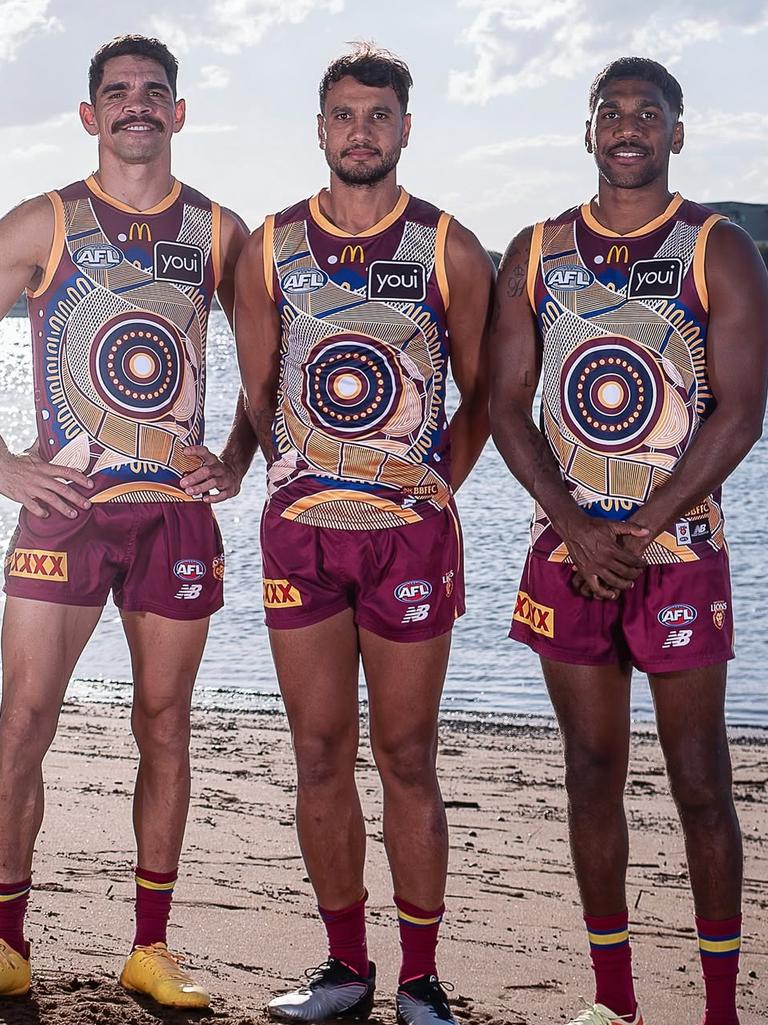
BRISBANE
Jordan Ah Chee (designer), the older brother of Brisbane premiership player Callum Ah Chee, brought together two families – the Ah Chee family and Lions family – to create this masterpiece that tells the story of Callum’s journey to the club through the four rivers depicted on the guernsey. The Mardooworra (Fitzroy River) in the Kimberley region of Western Australia depicts Callum’s birthplace. It represents his Nyikina and Yawuru connections. The Bilya Maadjit (Murray River), which runs through Noongar Boodja in the southwest of WA, represents Callum’s mother’s side of the family. The Maiwar (Brisbane River) and Birrarung (Yarra River) are important rivers in the history of the Brisbane Lions Football Club. Their coming together represents the creation and continuation of the club as it is today. The design around the rivers represents the people – families, staff, friends, fans and players – of the Brisbane Lions.
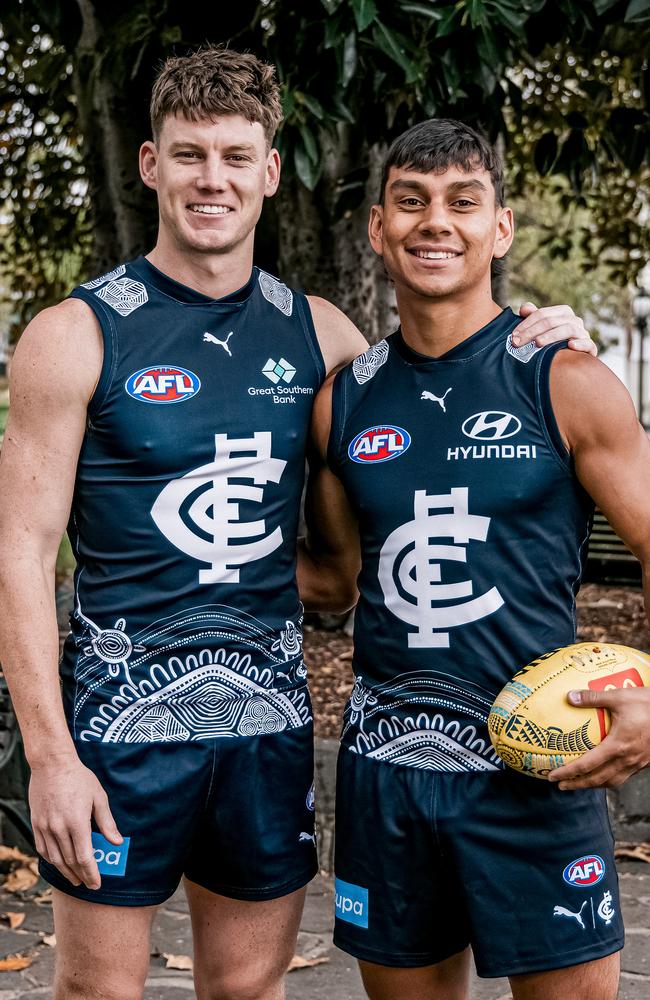
CARLTON
Designed by Luke and Siena Tieri – Yorta Yorta siblings and founders of art collective Bayadherra.
A shell design in the artwork is inspired by the Yorta Yorta animal totem, a long neck turtle. It features three journey lines in the centre, representing Carlton’s commitment to community in the past, present and future. The design also features yarning circles, circular meeting places and rings, which represent cultural knowledge elders have passed on.
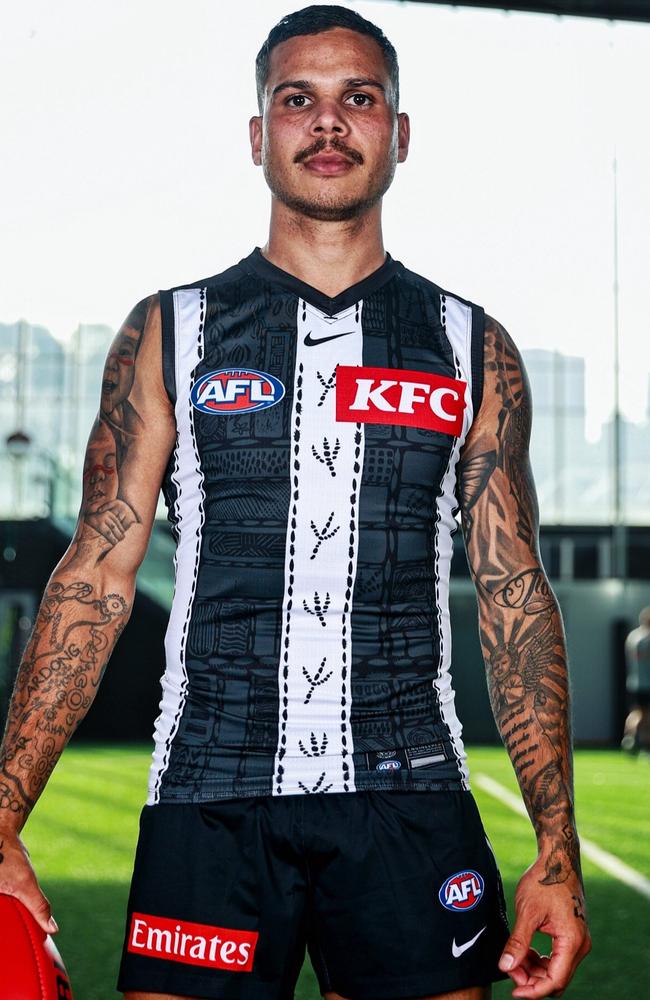
COLLINGWOOD
Collingwood’s guernsey has an emphasis on the significance of aligning with the seasons to ensure the survival of land, life and purpose. Designed by First Nations artist Lisa Thorpe, it is inspired by her art piece “Wooroongi Biik” and depicts the unity of the people to country, and features a magpie’s view of the town of Collingwood before colonisation.

ESSENDON
School students Lucas Waddleton and Lawson Richards designed the jumper through Ganbu Gulin (‘One Mob’) a program from The Long Walk at Taylors Lakes Secondary College.
Waddleton is a Tyerrernotepanner man and Richards is non-Indigenous.
The jumper represents Indigenous and non-Indigenous people coming together. Gum tree symbols signify a family tree, and circles represent people at a gathering place. Bird footprints going up the jumper represent animals and nature, showing all life coming together.
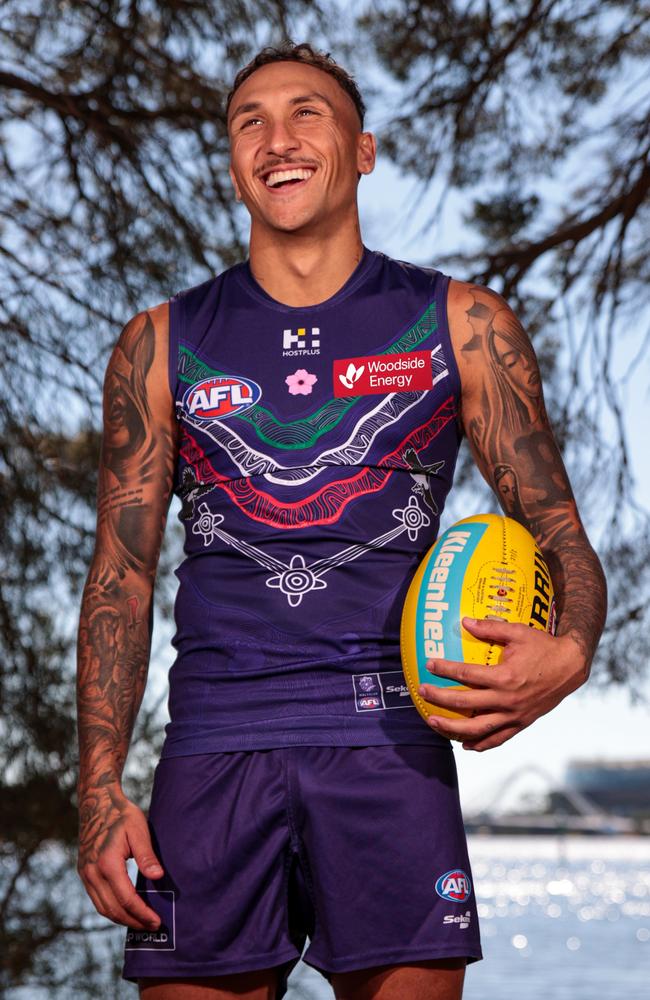
FREMANTLE/WALYALUP
It’s only fitting that one of Fremantle’s most exciting small forwards is behind this year’s jumper design. Jeff Farmer – alongside his father Jeff Farmer Snr and mother Iris all came together to produce the Dockers’ 2025 guernsey in collaboration with Roger Hayden. The design pays tribute to Farmer’s footballing journey and the history of Indigenous people in the Great Southern of Western Australia. Farmer played 249 AFL games, 131 of which were for the Dockers. The colours in the design – red, green, and white – are a callback to Farmer’s original Fremantle jumper that he wore on debut, replacing the modern white chevrons. The colours also symbolise represent the Palinup, Kalgan and Gordon-Frankland Rivers, three major water systems that run through Goreng, Menang and Kaniyang Noongar Country. Two Djiti-Djitis (Willie Wagtails) represent Farmer’s home town Tambellup and the tendency of the birds to eavesdrop on conversations in Noongar culture, which Farmer says symbolises how he was guided on his path to the AFL.
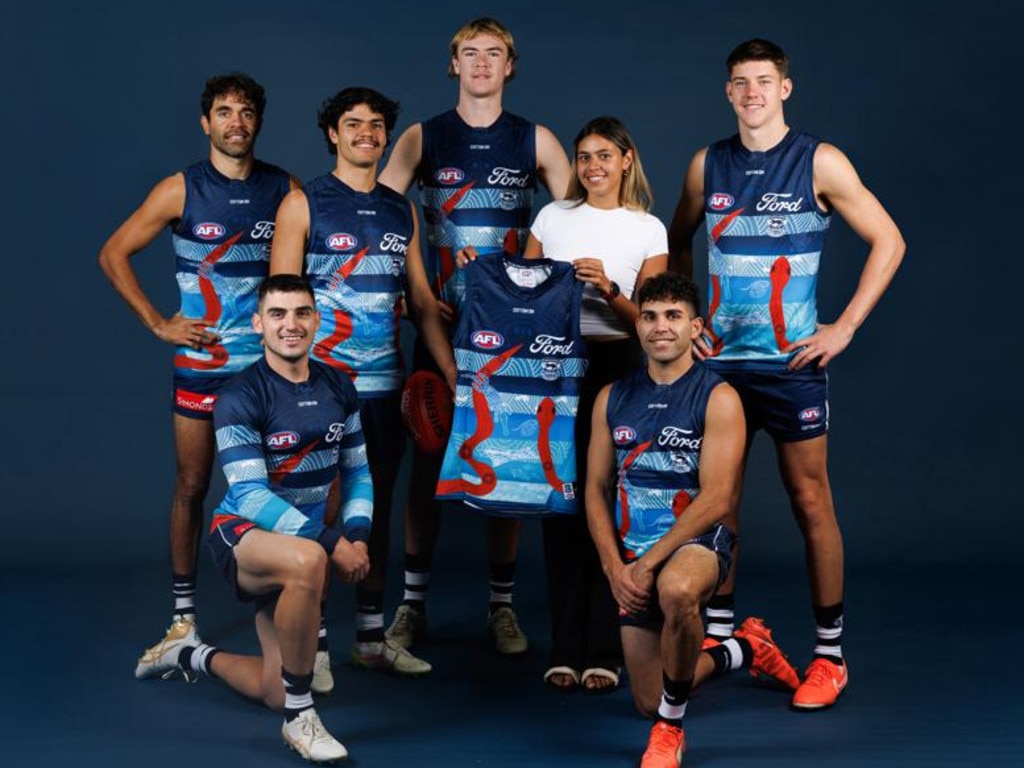
GEELONG
The sister of Cats player Lawson Humphries is behind this year’s design, with Meeza Humphries drawing on a typical day in the West Kimberleys where the family originates from.
Turquoise blue depicts the coastline and pindan dirt in the striking snake, with each hoop filled in by each of the Humphries siblings. The snake itself represents Lawson’s life and significant places for him, including where he has played his football and ending at Geelong.
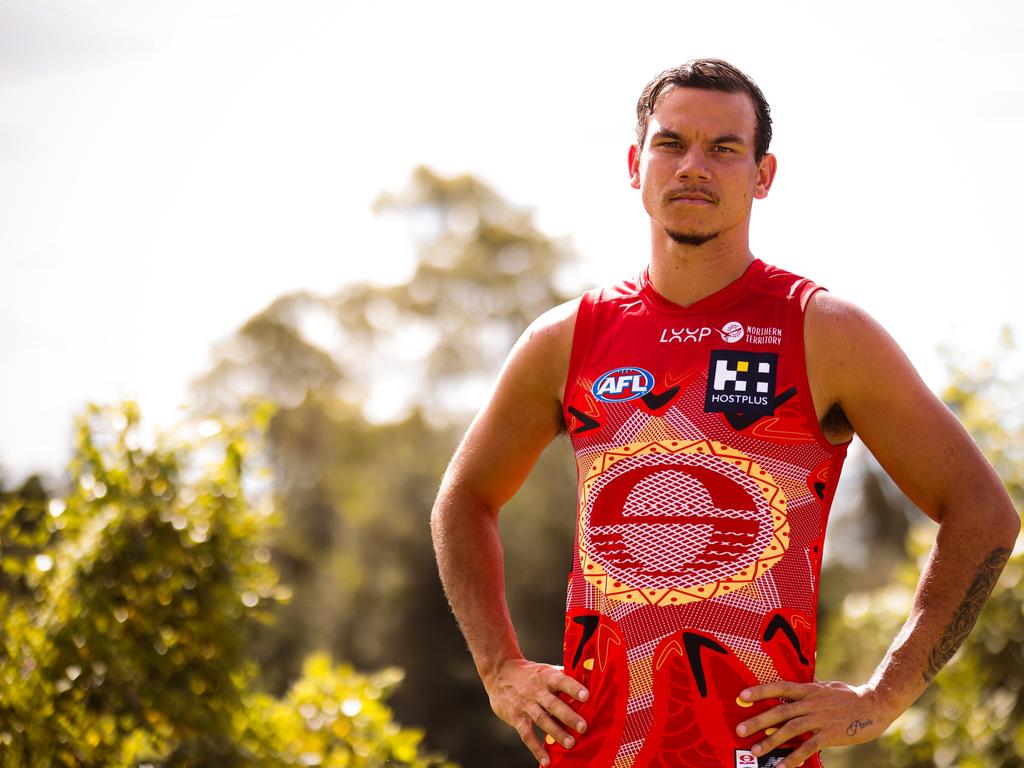
GOLD COAST
Darwin/Larrakia Guernsey (Round 9 & 10)
The Suns debuted their vibrant Larrakia guernsey designed by Keelan Fejo in last Saturday’s match against the Western Bulldogs in Larrakia and will wear it once more on Thursday night to open Sir Doug Nicholls Round against Hawthorn. The guernsey is inspired by the Nightcliff Jetty, one of Larrakia’s most iconic and scenic viewing locations where people gather to watch the sunset.
The central sun is the main element of Fejo’s design, representing strength and guidance. The crosshatching technique, called Rarrk or Rarrkbun, is from Fejo’s Mayali culture and taught to him by his father. In his culture, the sun represents the “giver of life and way of light to the land”. The boomerangs also represent strength and guidance. The No. 7 boomerang is one of the strongest weapons of the Aboriginal people across Australia. The dots and rays circling the sun represent the heat and pressure which the Suns players bring, and which other teams feel, when they play against them.
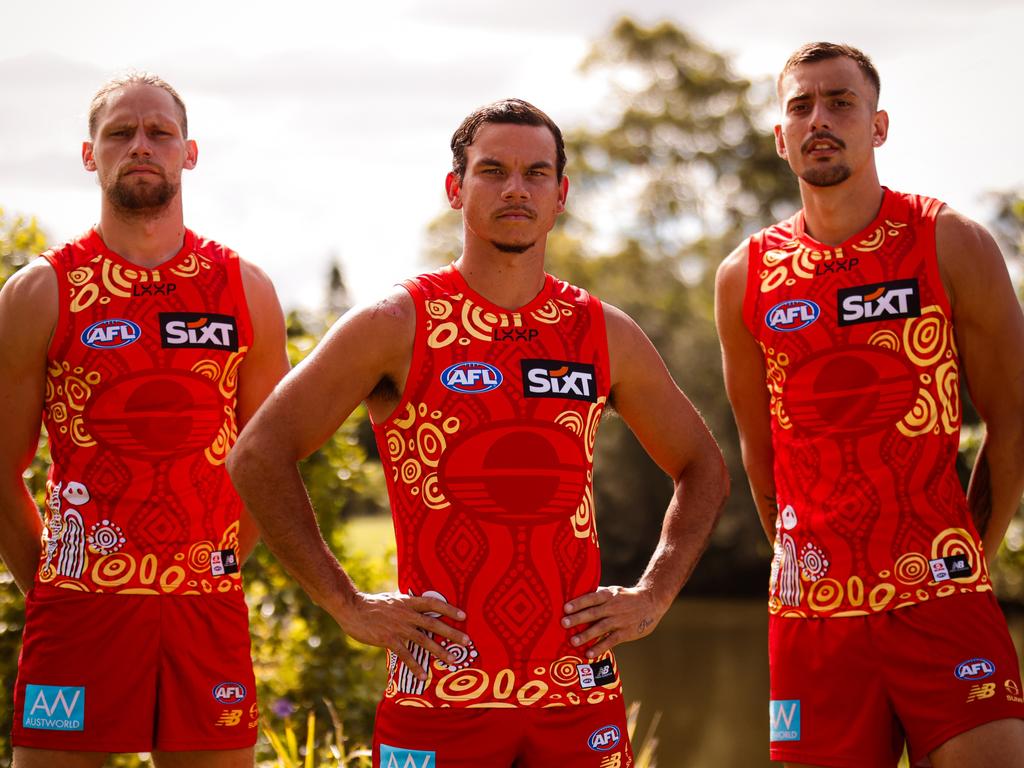
Indigenous Guernsey (Round 11)
The Suns will reprise their 2024 Indigenous guernsey, which is inspired by Garrara – the language name of the long lagoon that ran south to north in the region that is today known as the Gold Coast. It is represented by the feather motifs of the Bilin-Bilin (rainbow lorikeet), the Dun-Dun (swamp pheasant) and Mibin (eagle). The circular symbols of the design represent the sacred and cultural camps that the local Aboriginal people inhabit and maintain.
It is designed by Yugambeh and Bundjalung artists, Christine Slabb and Kyle Slabb.
GWS GIANTS
The Giants have refreshed the Maaluga Ngarriylanha guernsey, which means ‘sitting as one’, from last year’s Sir Doug Nicholls Round, by replicating the design but inverting the colours for 2025. The design by Gomeroi man Kayleb Waters will now sit on a white background with the guernsey yet again telling a story of unity and leadership, while representing the opportunities the Giants provide to communities from all backgrounds. Walters is a 26-year-old artist and a member of the Gomeroi Dance Company. On the guernsey is an artistic kangaroo inside the club’s trademark G on the front of the jumper, while the circular shapes represent mother Earth’s wisdom, knowledge and connection to country.

HAWTHORN
Not one but two jumpers for the Hawks, with a brown version that will be worn in round 10 and a gold version in rounds 11 and 17. The guernseys are designed by Jamie Bennell – Noongar and Yamatji man, Hawks Indigenous Player Development manager and 87-game Demon an Eagle.
Both are the same design, centred around a hunting hawk. The hawk is landing on the players and staff of the club. The left side design represents the club’s 13 premierships and the right a nod to the club’s home grounds: Glenferrie Oval, Princes Park, Waverley Park, UTAS Stadium and the MCG. A ‘nest’ backs the jumper design, representing the community, members, volunteers and fans that support Hawthorn.
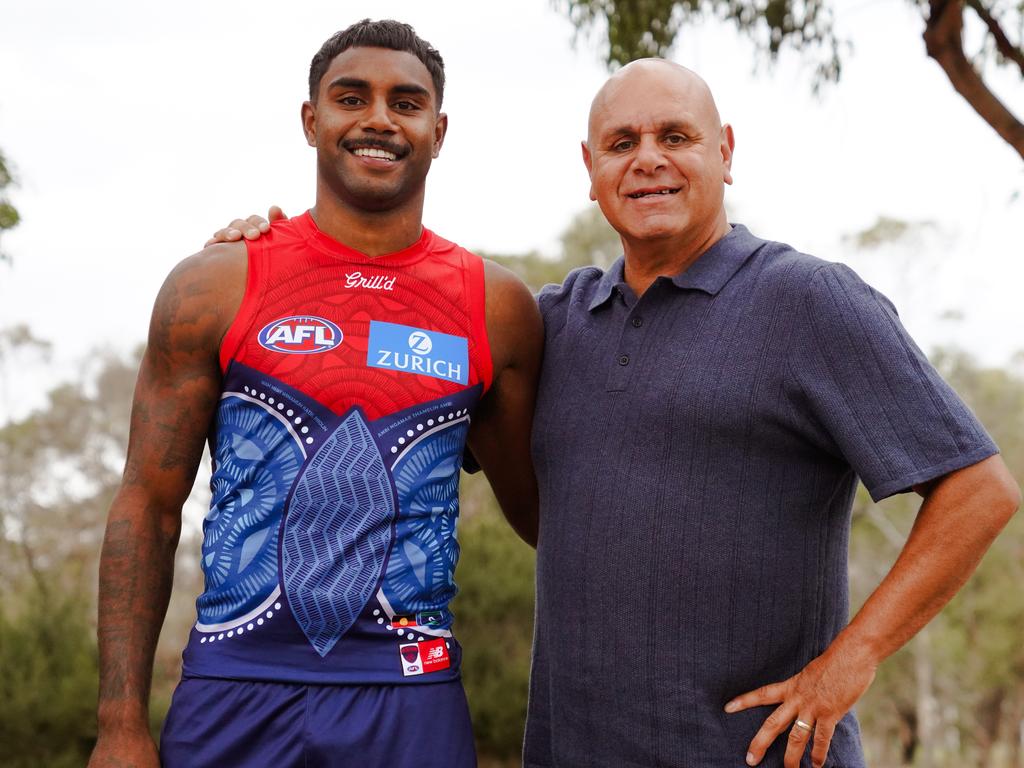
MELBOURNE/NAARM
Designed by Kevin Kropinyeri – Ngarrindjeri artist, comedian, sculptor and father of forward Kysaiah Pickett.
It features a shield at the centre of the jumper, representing the warriors (past present and future players) of the club, divine protection, faith and resilience. A weaving design features on the back, a nod to the important tradition for the Ngarrindjeri people. The names of all Indigenous players to represent the Demons sit on the lower back.

NORTH MELBOURNE
Titled ‘walert morrok goattak’, or possum skin in Woi Wurrung language, the design is inspired through discussions with Wemba Wemba, Gunditjmara, Ngadjonji and Taungurung artist Emma Bablett and senior Wurundjeri Elder Aunty Joy Murphy Wandin, given her connections to the club. Aunty Joy wears a possum skin when delivering a Welcome to Country and the front design replicates a possum skin cloak with symbols like an ochre, grinding bowl and manna gum leaf. The back includes a figure of a person, the club’s home Arden St Oval, kangaroo tracks and a Bunjil to recognise North Melbourne’s past First Nations players, ceremony and celebration.
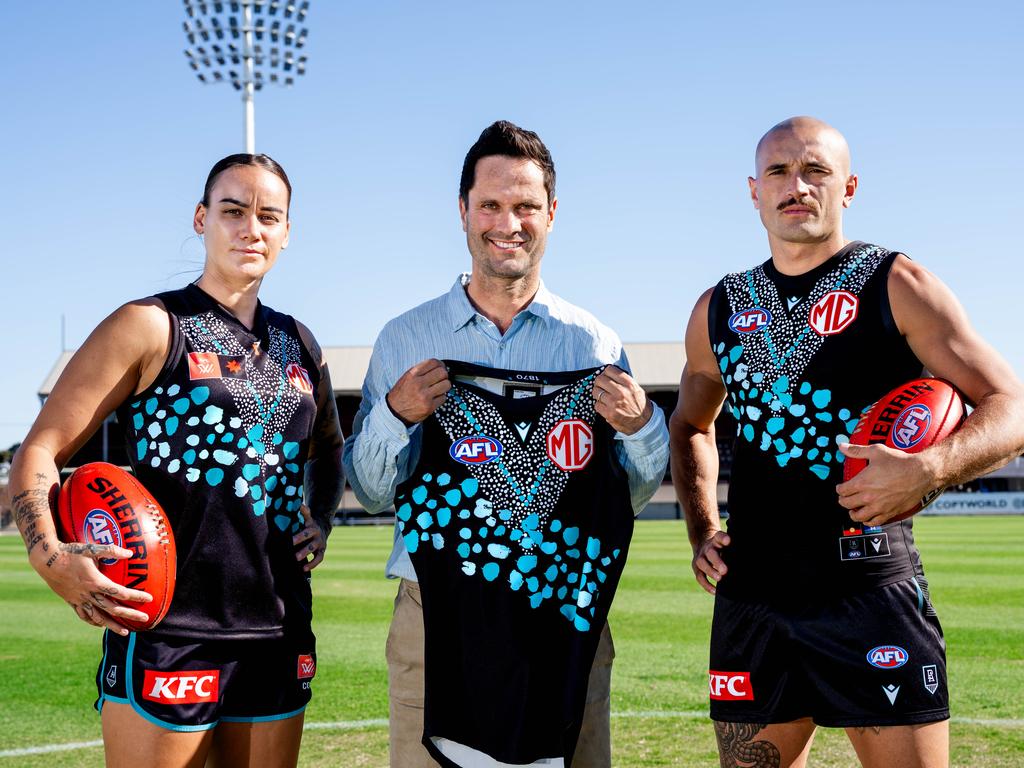
PORT ADELAIDE/YARTAPUULTI
Gavin Wanganeen is one of the great Indigenous players of the game, but he never got a chance to play in Sir Doug Nicholls Round.
But his journey and artwork will adorn the guernsey Port Adelaide – who will go by the name Yartapuulti – will wear over the next two weeks.
The design by the 1993 Brownlow Medallist reflects his cultural connection to the Milky Way, cherished memories of playing football at Alberton Oval and the people that make up the club.
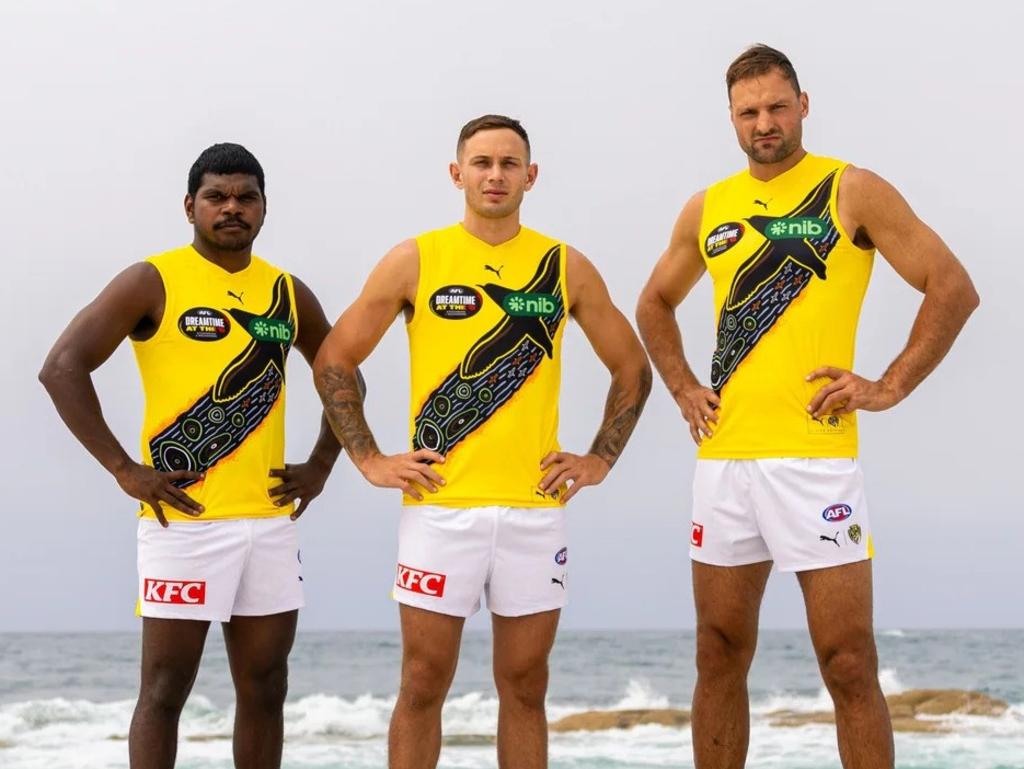
RICHMOND
Designed by the family of young Richmond player Rhyan Mansell, a proud Pakana person of northeastern Lutruwita (Tasmania), the jumper tells the story of their country. It shows the mutton bird on the front, which symbolises the connection to the local community, with the traditional Richmond sash featuring the flock, land, water, fire and smoke. The handprints on the back of the guernsey represent the Tigers players having each others backs on and off the field.
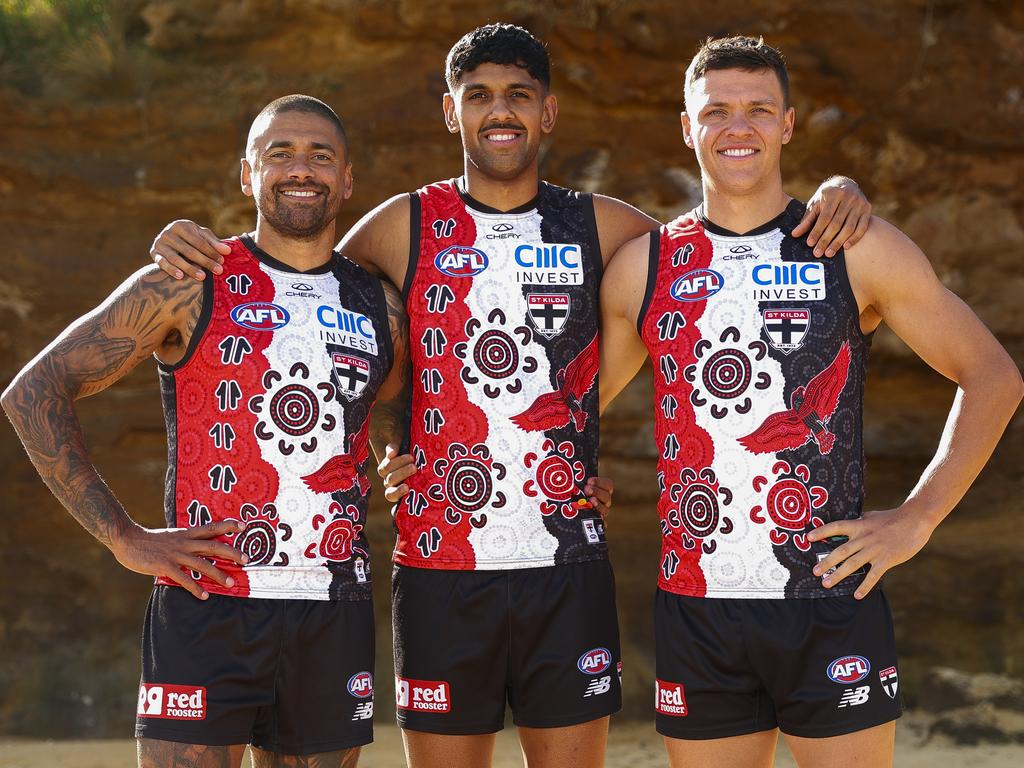
ST KILDA/EURO-YROKE
St Kilda star Nasiah Wanganeen-Milera has taken his football talents to design, with his artwork adorning the club’s Sir Doug Nicholls Round guernsey. The team is again adopting the name Euro-Yroke for the round, with the jumper depicting the story of the star playmaker’s upbringing and football journey in South Australia surrounded by family, friends and his journey to the club. It features large gathering symbols representing his two cultural groups with the third symbolising Moorabbin and other symbols representing the club’s current First Nations players.
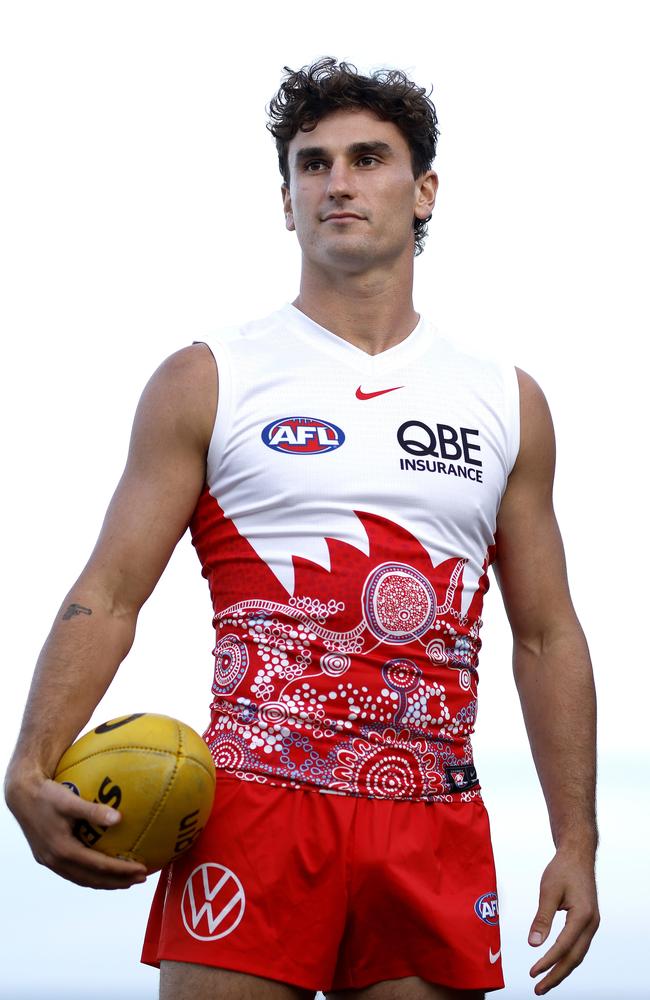
SYDNEY SWANS
The Swans’ new Indigenous guernsey for the AFL’s Sir Doug Nicholls Round, which also coincides with the club’s annual Marn Grook at the SCG, is titled ‘Wuri Wuri’ and was designed by renowned artist Jordan Adler. Adler’s art is already showcased around the Swans HQ at Moore Park, and they wanted to create a guernsey that replicates the designs. When translated, ‘Wuri Wuri’ in the Dharawal language means ‘sunshine’, with the central symbol on the design representing the SCG, the white lines at the top showcasing a mullet trail of travel and storytelling, while the four circular symbols represent the hard work, commitment, belief and respect that the club was built on. Ardler hails from the Bidjigal Clan and the La Perouse Aboriginal community, while also has a strong connection to the Swans with both her grandparents lifetime members of the club.
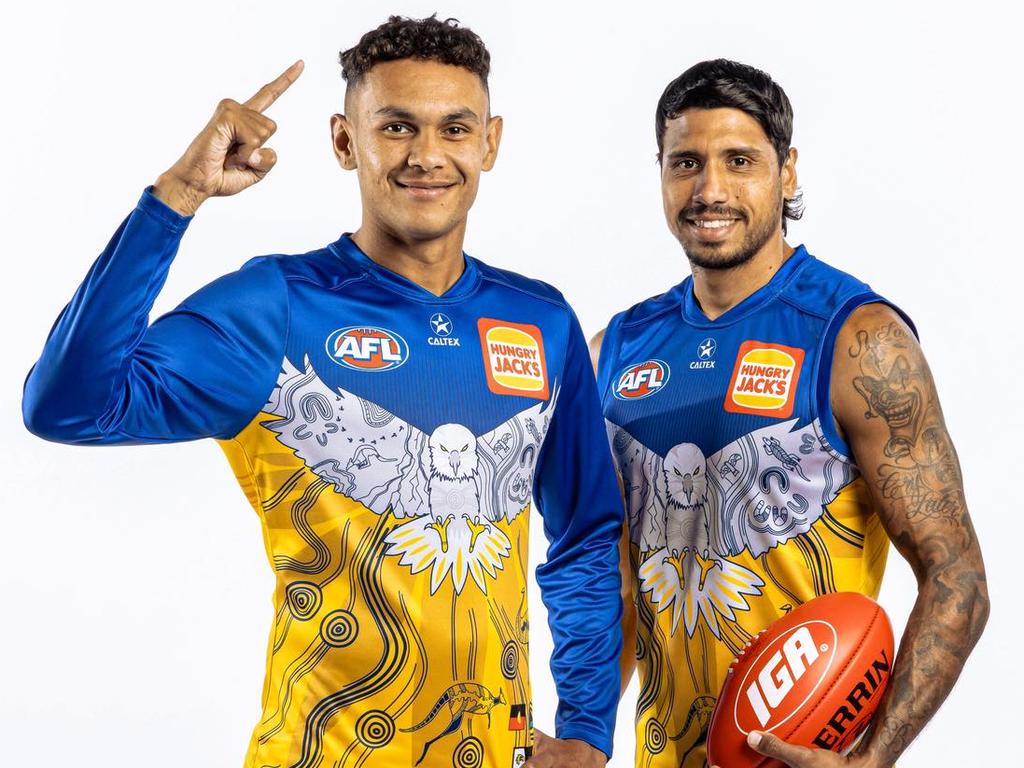
WEST COAST/WAALITJ MARAWAR
Designed by Wongutha man Kevin Wilson and Maduwongga and Noongar woman Taryn Woods, West Coast’s design highlights the importance of family and connection. The striking blue and gold artwork features totems of each of the club’s First Nations players’ families. 56 sharp points represent the First Nations players drafted since the Eagles’ inception and the kangaroo and the emu at the bottom of the jumper symbolise the players always moving forward and progressing as a team. Six large circles and a series of rivers and waterways represent the players’ connection to their country, each other, the continent, and their cultures.
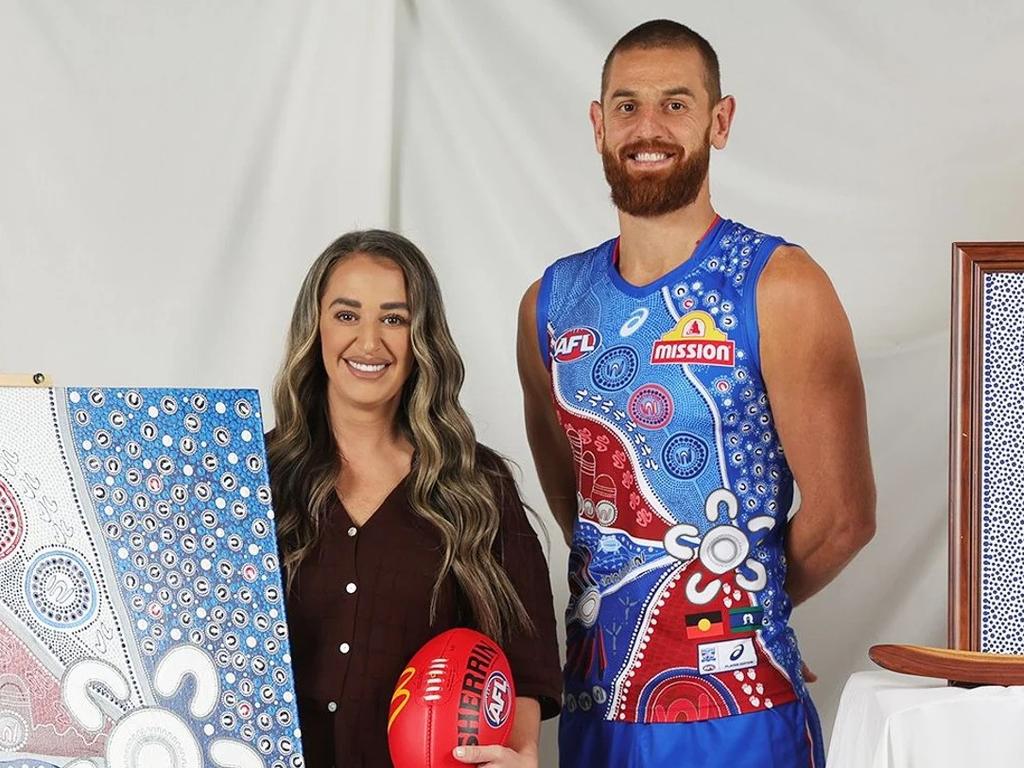
WESTERN BULLDOGS
Designed by Kamilya Lowana White, the Bulldogs’ guernsey celebrates the team’s current First Nations players and also the club’s reconciliation journey. The club is depicted as a meeting point in its centre, with each section – for each player in Ryley Sanders, Jamarra Ugle-Hagan, Arty Jones, Liam Jones and Naomi Ferres – surrounding it and telling part of their respective story.
Originally published as Sir Doug Nicholls Round: Every AFL club’s Indigenous round guernsey – and their meaning

